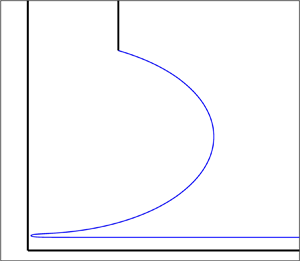Article contents
New exotic capillary free-surface flows
Published online by Cambridge University Press: 29 July 2020
Abstract

In this paper, we consider two-dimensional steady free-surface flows where gravity is ignored, but the effects of surface tension are included. It is found that the existence of an additional solid boundary can allow for previously unseen limiting configurations as the surface tension tends to infinity. The free surface of these new solutions is formed of straight lines, arcs of circles and a point where the flow turns at a wall. These limiting configurations form endpoints of solution branches of capillary free-surface flows. Other endpoints of these branches include the surface tension free (i.e. free streamline) solution, and a solution whose free surface is composed simply of a straight line. The model we explore is flow incoming along a channel of constant width. One of the walls terminates, where the fluid is forcibly separated from the wall and a free boundary is formed. The other wall meets a second straight boundary with interior angle  $\beta$. Far downstream the solution approaches a uniform stream. Making use of Cauchy's integral formula, the unknowns are expressed in terms of values on the boundary. The integral equations are then solved numerically. The solution space relative to the parameter values of the model is discussed.
$\beta$. Far downstream the solution approaches a uniform stream. Making use of Cauchy's integral formula, the unknowns are expressed in terms of values on the boundary. The integral equations are then solved numerically. The solution space relative to the parameter values of the model is discussed.
JFM classification
- Type
- JFM Rapids
- Information
- Copyright
- © The Author(s), 2020. Published by Cambridge University Press
References
REFERENCES
- 1
- Cited by




